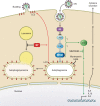Influenza lung injury: mechanisms and therapeutic opportunities
- PMID: 26408556
- PMCID: PMC4652148
- DOI: 10.1152/ajplung.00283.2015
Influenza lung injury: mechanisms and therapeutic opportunities
Abstract
In this Perspectives, we discuss some recent developments in the pathogenesis of acute lung injury following influenza infection, with an emphasis on promising therapeutic leads. Damage to the alveolar-capillary barrier has been quantified in mice, and agents have been identified that can help to preserve barrier integrity, such as vasculotide, angiopoietin-like 4 neutralization, and sphingosine 1-phosphate mimics. Results from studies using mesenchymal stem cells have been disappointing, despite promising data in other types of lung injury. The roles of fatty acid binding protein 5, prostaglandin E2, and the interplay between IFN-γ and STAT1 in epithelial signaling during infection have been addressed in vitro. Finally, we discuss the role of autophagy in inflammatory cytokine production and the viral life cycle and the opportunities this presents for intervention.
Keywords: acute lung injury; autophagy; influenza; signaling.
Copyright © 2015 the American Physiological Society.
Figures

References
-
- Boyle AJ, McNamee JJ, McAuley DF. Biological therapies in the acute respiratory distress syndrome. Expert Opin Biol Ther 14: 969–981, 2014. - PubMed
-
- Chen XJ, Seth S, Yue G, Kamat P, Compans RW, Guidot D, Brown LA, Eaton DC, Jain L. Influenza virus inhibits ENaC and lung fluid clearance. Am J Physiol Lung Cell Mol Physiol 287: L366–L373, 2004. - PubMed
Publication types
MeSH terms
Substances
Grants and funding
LinkOut - more resources
Full Text Sources
Other Literature Sources
Medical
Research Materials
Miscellaneous

